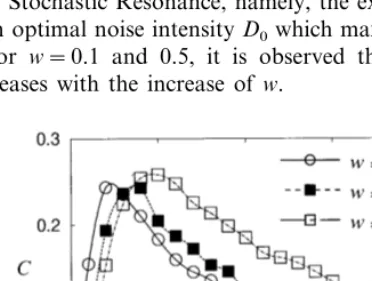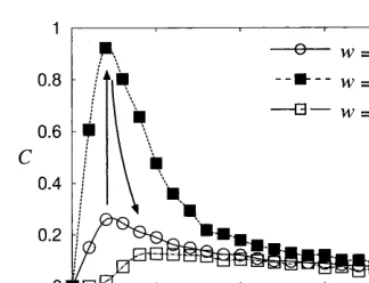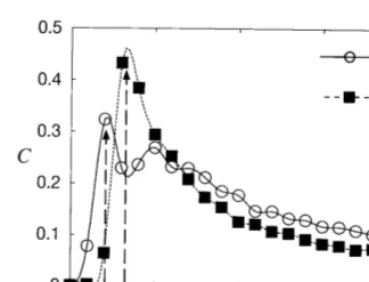Stochastic resonance in a pulse neural network with a
propagational time delay
Takashi Kanamaru *, Yoichi Okabe
Res.Centre for Ad6.Sc.and Tech.,The Uni6ersity of Tokyo,4-6-1Komaba,Meguro-ku,Tokyo153-8904,Japan
Abstract
Stochastic resonance in a coupled FitzHugh – Nagumo equation with a propagational time delay is investigated. With an appropriate set of parameter values, i.e. the frequency of the periodic input, the propagational time delay, and the coupling strength, a deterministic firing induced by additive noise is observed, and its dependence on the number of neurons is examined. It is also found that a network composed of two assemblies shows a competitive behavior under control of the noise intensity. © 2000 Elsevier Science Ireland Ltd. All rights reserved.
Keywords:Stochastic Resonance; FitzHugh – Nagumo equation; Correlation coefficient; Propagational time delay; Noise-induced deterministic firing
www.elsevier.com/locate/biosystems
1. Introduction
Recently, Stochastic Resonance (SR) has at-tracted considerable attention. This is a phe-nomenon where a weak input signal is enhanced by its background noise (for reviews, see Dykman et al., 1995; Gammaitoni et al., 1998; Wiesenfeld and Jaramillo, 1998).
Particularly, SR in neural systems has been widely investigated by numerous authors. Theo-retically, SR in a single neuron model, e.g. the leaky integrate-and-fire model (Bulsara et al., 1996; Shimokawa et al., 1999), or the FitzHugh – Nagumo model (Longtin, 1993; Wiesenfeld et al., 1994), has been often analyzed, and it has been
proposed that the biological sensory systems uti-lize their background noise to improve their sensi-tivity to external inputs. Experimentally, it is observed that mechanoreceptor cells of a crayfish with additive noise (Douglass et al., 1993) and caudal photoreceptor interneurons of a crayfish with intrinsic noise (Pei et al., 1996) show the property of SR. In these works, the background noise is implicitly regarded as due to thermal fluctuations, but there may be more origins of fluctuation in neural systems, e.g. internal chaos, or numerous synaptic inputs (Mato, 1998; Saku-mura and Aihara, 1998; Mato, 1999). With such noise sources, SR may play more functional roles in neural systems, e.g. the information processing in the brain. To treat such dynamics, SR in coupled systems must be considered, and some new features have been reported. Collins et al. (1995) investigated the dynamics of the ensemble
* Corresponding author.
E-mail address: [email protected] (T. Kanamaru).
of FitzHugh – Nagumo equations and showed that controlling the noise intensity is not required. Kanamaru et al. (1999) considered SR in a diffu-sively coupled FitzHugh – Nagumo equation, and investigated the dependence of the system on the coupling strength and the number of neurons.
In the present paper, we investigate a coupled FitzHugh – Nagumo equation with propagational time delay, which models the time for a pulse to propagate on the axon from the pre-synaptic neu-ron to the post-synaptic neuneu-ron. In Section 2, a coupled FitzHugh – Nagumo equation and the correlation coefficient which measures the correla-tion between two pulse trains are defined. In Section 3, the behavior of the system without the propagational time delay (Kanamaru et al., 1999) is briefly summarized. In Section 4, the system with a propagational time delay is considered. With an appropriate set of system parameters, a deterministic firing induced by additive noise is observed, and its dependence on the number of neurons is investigated. In Section 5, we construct a network composed of two assemblies and exam-ine a competitive behavior in the network by controlling the noise intensity. Conclusions and discussions are given in the last section.
2. Coupled FitzHugh – Nagumo equation and correlation coefficient
In the present paper, we treat a coupled FitzHugh – Nagumo (FN) equation with a propa-gational time delay, written as
tu;i= −6i+ui−ui
0.8, ui is the fast variable which denotes the internal state of the ith neuron, 6i is the slow
variable which represents the refractory period,w
is the coupling strength,gi(t) is the coupling term,
S(f;t) is the periodic pulse train with height I, width h, and frequency f, ji(t) is Gaussian white
noise with intensity D, dij is Kronecker’s delta,
and dp is the propagational time delay from the
jth neuron to theith neuron. Note that the noises for different neurons are statistically independent, the coupling strengths and the propagational time delays are uniform in the network, and the cou-pling is diffusive, i.e. for a large enough w and
dp=0 the neurons synchronize each other. With
the above configurations, a single FN model shows a characteristic of an excitable system, namely, it has a stable rest state, and with an appropriate amount of disturbance it generates a pulse with a characteristic magnitude of height and width. The parameters of the periodic pulse train S(f;t) are set as f=0.1, I=0.15, and h=
0.3. Note that the height I is so small that no neuron generates a pulse without noise.
By the symmetry of the system, the behaviors of all the neurons are statistically identical, and we regard the internal state u1 of the first neuron
as the output of the network. Let us define the correlation coefficient C between the input and output pulse trains (Palm et al., 1988). Firstly, to incorporate the effect of the firing delay df of the FN model, which is the time lag of firing since an input pulse is injected, the shift t t−df is applied to the time series of the output pulse train. Then the time series are divided into n bins of the width D, and the number of pulses in the
ith bin is denoted as Xi and Yi for the input and output pulses, respectively. Note that the widthD is sufficiently small so that Xi and Yi take the value 0 or 1. Then X=Xi and Y=Yiare the
numbers of input and output pulses respectively, and Z=XiYi is the number of coincident
firings. The correlation coefficient C between the input and output pulse train is defined as
C= Z−(XY)/n
X(1−X/n)Y(1−Y/n)
Consider the periodic input with the frequency f
such that
Xi=
!
1 if iDmodf−1B
D
0 otherwise . (7)
If the output seriesYiis identical withXi, namely, if the relation Xi=Yi is satisfied for all i, the correlation coefficient C takes the value 1. If the output series Yi has no correlation with Xi, the correlation coefficient C takes the value 0 in the large n limit.
3. The case ofdp=0: stochastic resonance in the
coupled system
In this section, we briefly describe the results fordp=0 (Kanamaru et al., 1999). As previously mentioned, the frequency of the input pulse train is fixed atf=0.1. Firstly, the system withN=2 is examined for simplicity.
The dependence of the correlation coefficientC
on the noise intensityDis shown in Fig. 1, for the coupling strength w=0, 0.1, and 0.5. For w=0, the system reduces to a single neuron, and the correlation coefficient C shows the characteristic of Stochastic Resonance, namely, the existence of an optimal noise intensityD0 which maximizesC.
For w=0.1 and 0.5, it is observed that D0
in-creases with the increase ofw.
Fig. 2. The dependence of the optimal noise intensity D0 on the coupling strength w for the propagational time delay dp=0.
In Fig. 2, the dependence ofD0on the coupling
strength w is investigated numerically. It is ob-served that the optimal noise intensity D0
in-creases monotonically with the increase of w, and it converges to about 0.0028. In the following, this limit value is denoted by D0().
To consider the dependence of D0() on the
number N of neurons, we introduce x(i)
=
(ui,6i)
t,j(i)=(j
i, 0)
t, and a two dimensional
diag-onal matrix A with diagonal components A11=1
and A22=0, we rewrite the coupled FitzHugh –
Nagumo equation as
x;(i)=F(x(i))+wG
i(t)+x
(i), (8)
Gi(t)= Á Ã Í Ã Ä
A
1 N−1j%"i(x(j)−x(i))
if N]20 if N=1
,
(9)
ji(t)jj(t’)=Ddijd(t−t’), i, j=1,2,…,N,
(10) where F(x(i)) describes the dynamics of ith
neu-ron. Let us define the mean value X and the deviation dx(i) from Xas
X=1
N%i
x(i), (11)
dx(i)=x(i)−X, (12)
then, for large w, X anddx(i) obeys
X: =F(X)+ %
wherebis the parameter of the FN model Eq. (2). Thus the variances of dx1(i) and dx2(i) are esti-cate that the dynamics of each neuron for largew
approaches the dynamics of one neuron with the scaled noise intensity D/N. So, between the opti-mal noise intensity D0
(N)
() for N neurons and
D0(1)() for one neuron, the relation
D0(N)()=ND0(1)() (18)
holds.
In Fig. 3, the numerically obtained optimal noise intensityD0() is plotted against the
num-berNof neurons, where D0() is estimated with
the coupling strength w=1.0, which is large enough for the saturation of D0. A good
agree-ment with the analytical result (18) is observed.
Fig. 4. The dependence of the correlation C on the noise intensity Dfor the propagational time delaydp=10.
4. The case of dp"0: noise-induced deterministic
firing
In this section, the system withdp"0 is treated. Firstly, the system with N=2 is considered for simplicity. The frequency of the input pulse train is fixed at f=0.1 again.
For dp=10, the firing at some moment may affect the firing in the next period of S(f;t) since 1/f=10. The dependence of the correlation coeffi-cient C on the noise intensity D for w=0, 0.12 and 0.16 with dp=10 is shown in Fig. 4. Similar to the case ofdp=0, the correlation coefficientC
has a peak at an optimal noise intensity D0 for
w=0, and D0 increases with the increase of w.
But it is also observed that the peak value of C
decreases with the increase ofw, unlike the case of
dp=0. This difference of the behavior for dp=0 and 10 may come from the fact that the synchro-nized solution u1(t)=u2(t−dp) andu2(t)=u1(t−
dp) cannot lock to the input pulse trainS(f;t) for
dp=10.
Next, we treat the case withdp=1/f−df 9.7. Note that in this case an output pulse, which fires with the delay df after an input pulse is injected, can synchronize with the next input pulse. The correlation coefficient Cfor w=0, 0.12, and 0.16 with dp=9.7 is plotted in Fig. 5, where each C
shows the existence of the maximum. Note that the maximum of Cforw=0.12 reaches almost 1, which indicates that for D0.001, noise-induced deterministic firing (NIDF), namely, a 1:1 phase
Fig. 5. The dependence of the correlation C on the noise intensityDfor the propagational time delaydp=10−df9.7.
Fig. 7. The dependence of optimal noise intensityD0 on the numberNof neuron for the noise-induced deterministic firing.
5. Competition of two assemblies under noise
Using the preceding properties of SR in a cou-pled FN equation with a propagational time de-lay, we construct a network composed of two assemblies, in which a competitive behavior takes place by controlling the noise intensity. Firstly, let us define the superimposed periodic pulse train (SPPT) as
T(t)= max
15i5m
S(fi;t), (19)
where m is the number of periodic components, and fi is the frequency of each periodic compo-nent. In the following, we set m=2, f1=0.1,
f2=f1/2, andI=0.15. Note that the heightIof
T(t) is so small that it cannot make each neuron generate a pulse without the noise. The SPPTT(t) is injected to the network composed of two assem-blies, shown in Fig. 8. The assembly one is com-posed of two neurons, namely Eq. (1) and Eq. (2) with N=N1=2, dp=d11/f1−df and T(t)
in-stead ofS(f;t), and assembly two is composed of locking between the input and the output, takes
place. Forw=0.16, this locking behavior is bro-ken and the maximum decreases to about 0.1.
To investigate the range of w where NIDF takes place, the correlation coefficient Cwith the fixed noise intensityD=0.001 fordp=0, 9.7, and 10 is plotted againstwin Fig. 6. It shows that the coupling strength w which enables NIDF is around w=0.12 for dp=9.7. NIDF also takes place for N\2 with dp=9.7 and w0.12 (data not shown), but its optimal noise intensityD0has
a dependence on the numberNof neurons. D0 is
shown as a function of N in Fig. 7. The monotonic increase ofD0withN, and the
conver-gence of D0 to about 0.002 is observed.
Fig. 6. The dependence of the correlation coefficientCon the
Fig. 9. The dependence of the correlationsC1andC2 on the noise intensityD.
the SPPT T(t) is separated to each periodic com-ponent by controlling the noise intensity. This implies that the fluctuation in a network might be used as a parameter of its dynamics. Secondly, the synchronously oscillating assembly is rearranged by controlling the noise intensity. For example, for D0.001, the observed neuron belongs mainly to the assembly one in which each neuron fires synchronously with frequency f1, and for
D0.002, it belongs to the assembly two in which the periodic firing with frequency f2 is
dominant. These new features suggest that the fluctuations in the brain might have a functional role in the information processing.
6. Conclusions and discussions
Concerning SR, new features of the noisy pulse neural network with propagational time delay are reported. When the propagational time delay dp
and the frequency f of the periodic input pulse train satisfy the relationship dp=1/f, an optimal noise intensity which maximizes the correlation coefficient is increased with the increase of the coupling strength, and the peak value of the cor-relation coefficient decreases with the increase of the coupling strength. For the delay of propaga-tiondp=1/f−df dependent on the firing delaydf, a deterministic firing is induced at the optimal noise intensity, which increases with the increase of the number of neurons.
Using these properties, a network composed of two assemblies is constructed. It separates a su-perimposed periodic pulse train, and its dynamics can be controlled by noise, In this network, the rearrangement of the synchronously oscillating assembly by controlling the noise intensity is observed.
If the environment in the brain where each neuron operates is highly fluctuating due to ther-mal noise, internal chaos, numerous synaptic in-puts, or other possible sources of noise, the above results suggest that such fluctuations might play a similar role as a parameter of dynamical systems, and be significant for the information processing in the brain.
eight neurons, namely, Eq. (1) and Eq. (2) with
N=N2=8,dp=d21/f2−dfandT(t) instead of
S(f;t). Note that there is a neuron which belongs to both assemblies simultaneously, and we regard its output as the output of the network. The coupling strength w is set at w=0.12 so that NIDF takes place with a suitable noise intensity. By the definition of the delay d1 and d2, it is
expected that NIDFs with frequencyf1andf2take
place in the assembly one and two, respectively. Then two correlation coefficients C1 and C2 are
defined as the correlations between the output pulse train of the network and the periodic pulse trainS(f1;t) andS(f2;t), respectively. A largeC1
indicates that the observed neuron is dominated by the synchronized oscillation in the assembly one, and a large C2 indicates the domination of
the assembly two.
The dependence of C1 and C2 on the noise
intensity D are shown in Fig. 9, which indicates that the optimal noise intensity D0 is D00.001
for C1, and D00.002 for C2. Note that C1 is
suppressed when C2 is around the maximum
value. The difference between optimal noise inten-sities forC1andC2, is caused by the fact that the
optimal noise intensityD0depends on the number
Nof neurons (see Fig. 7).
Acknowledgements
The author (T.K.) is grateful to Prof. Takehiko Horita for his helpful discussion and encourage-ment.
References
Bulsara, A.R., Elston, T.C., Doering, C.R., Lowen, S.B., Lindenberg, K., 1996. Cooperative behavior in periodically driven noisy integrate-fire models of neuronal dynamics. Phys. Rev. E. 53, 3958 – 3969.
Collins, J.J., Chow, C.C., Imhoff, T.T., 1995. Stochastic reso-nance without tuning. Nature 376, 236 – 238.
Douglass, J.K., Wilkens, L., Pantazelou, E., Moss, F., 1993. Noise enhancement of information transfer in crayfish mechanoreceptors by stochastic resonance. Nature 365, 337 – 340.
Dykman, M.I., Luchinsky, D.G., Mannella, R., McClintock, P.V.E., Stein, N.D., Stocks, N.G., 1995. Stochastic reso-nance in perspective. Nuovo. Ciment D. 17, 661 – 683. Gammaitoni, L., Ha¨nggi, P., Jung, P., Marchesoni, F., 1998.
Stochastic resonance. Rev. Mod. Phys. 70, 223 – 287. Kanamaru, T., Horita, T., Okabe, Y., 1999. Stochastic
reso-nance for the superimposed periodic pulse train. Phys. Lett. A. 255, 23 – 30.
Longtin, A., 1993. Stochastic resonance in neuron models. J. Stat. Phys. 70, 309 – 327.
Mato, G., 1998. Stochastic resonance in neural systems: effect of temporal correlation in the spike trains. Phys. Rev. E. 58, 876 – 880.
Mato, G., 1999. Stochastic resonance using noise generated by a neural network. Phys. Rev. E. 59, 3339 – 3343.
Palm, G., Aertsen, A.M.H.J., Gerstein, G.L., 1988. On the significance of correlations among neuronal spike trains. Biol. Cybern. 59, 1 – 11.
Pei, X., Wilkens, L.A., Moss, F., 1996. Light enhances hydro-dynamic signaling in the multimodal caudal photoreceptor interneurons of the crayfish. J. Neurophysiol. 76, 3002 – 3011.
Sakumura, Y., Aihara, K., 1998. Stochastic resonance by modulation detecting neuron. In: Usui, S., Omori, T. (Eds.), Proceedings of the fifth International Conference on Neural Information Processing. Ohmsha, Tokyo, pp. 951 – 954.
Shimokawa, T., Pakdaman, K., Sato, S., 1999. Time-scale matching in the response of a leaky integrate-and-fire neuron model to periodic stimulus with additive noise. Phys. Rev. E 59, 3427 – 3443.
Wiesenfeld, K., Jaramillo, F., 1998. Minireview of stochastic resonance. CHAOS. 8, 539 – 548.
Wiesenfeld, K., Pierson, D., Pantazelou, E., Dames, C., Moss, F., 1994. Stochastic resonance on a circle. Phys. Rev. Lett. 72, 2125 – 2129.



